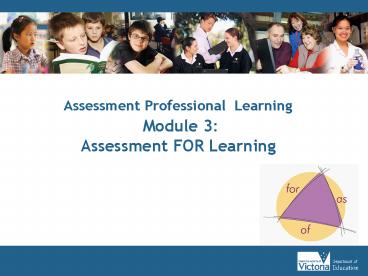Assessment Professional Learning Module 3: Assessment FOR Learning PowerPoint PPT Presentation
1 / 20
Title: Assessment Professional Learning Module 3: Assessment FOR Learning
1
Assessment Professional Learning Module 3
Assessment FOR Learning
2
(No Transcript)
3
Assessment FOR learningoccurs when teachers use
inferences about student progress to inform
their teaching.
- Assessment OF learning
- occurs when teachers use evidence of student
learning to make judgements on student
achievement against goals and standards.
- Assessment AS learning
- occurs when students reflect on and monitor their
progress - to inform their future
- learning goals.
4
- Assessment FOR learning
- occurs when teachers use inferences
- about student progress to inform
- their teaching.
- It is frequent, formal or informal (e.g. quality
questioning, anecdotal notes, written comments),
embedded in teaching and provides clear and
timely feedback that helps students in their
learning progression. It has a summative use,
providing evidence that informs, or shapes, short
term planning for learning.
5
- Assessment FOR learning
- makes a significant difference to students
progress - in their ability to be confident,
critical learners, to achieve more than ever
before and in raising their self-esteem. In a
world of continuing pressure, it is good to know
that we are making a real difference - (Shirley Clarke 2001, p. 139)
6
The most important purpose of classroom
assessment is to improve student learning.The
learner is at the centre.
7
The teachers role is to
- make arrangements to gain evidence on students
learning progression - provide timely feedback
- modify the learning and teaching program in light
of the assessment evidence.
8
Gaining evidence FOR learning can happen in
these four ways
Informal Formal
Before new learning starts asking questions brainstorming (informal diagnostic) Torch test quick quiz (formal diagnostic)
During learning process observe class work and see where problems occur (informal formative) read and give feedback on homework (formal formative)
9
Means of gaining evidence of students learning
- Ask quality questions that probe students
understandings and help them think in different
ways about their learning. - Observe and record student actions and learning
progression to modify teaching plans. - Listen to what students have to say (and hear the
message). - Closely watch individual students who differ from
the majority, who signal to you when it is time
to try something different.
10
Means of giving feedback to students
- Have a conversation (formal or informal) about
the quality of the students work. - Give written feedback - this can be detailed and
focused on what the student can do to improve. - Talk with students about your analysis of their
individual learning progression against the
Standards at an interim point (i.e. not at the
end).
11
Quality questions
- Wait time more than 3 seconds
- (Count if need be one thousand, two thousand,
three thousand). Produces extended responses and
students are less concerned with being right
and more concerned with ideas. - Ask, pause, use a name to direct
- Ensures all are attending to the question - and
thinking - Open-ended
- Where hypotheticals, possibilities and creative
responses are encouraged - Challenging
- Beyond remember and understand (in a
simplistic way) - Distributed evenly
- Around the room - no hands up (allows some to
disengage)
12
A checklist for good feedback
- 1. clear and unambiguous
- 2. specific
- 3. supportive, formative and developmental
- 4. timely
- 5. understood
- 6. delivered in an appropriate environment
- (Jonathan Tummons, 2005, p. 76).
13
Annotations on student work.What do you write?
- Question mark
- Circling
- Underlining or sidebars
- Ticks and crosses
- caret (omission)
- Spelling or grammar corrections
- Written comments
- Are all of these helpful for students learning?
14
Common types of written feedback
- Regulatory instructions
- e.g. use Australian spelling conventions
- Advisory comments
- e.g. you could elaborate the conditions here
- Descriptive observation
- e.g. you have used 3 web sources in this report
- Rhetorical questions
- e.g. how does this relate to Xs ideas?
- PLUS
15
Common types of written feedback
- Direct criticism
- e.g. you needed to draw on other peoples ideas
here - Praise
- e.g. your introduction is clearly written and
sets the tone well - Correctness (it is right - or wrong)
- e.g. you have misunderstood the key idea here.
- (types from Catherine Haines 2004)
16
Consider
- Legibility
- Can students read your feedback?
- Can they understand your meaning?
- Importance
- Are you giving feedback on the highest priority
aspects of the work? - Quality
- Are your comments constructive, written
politely, and with suggestions to help students
learning?
17
Consider
- Quantity
- Is there a manageable amount for students to
absorb and act upon? - Timing
- How often?
- How timely?
- Style
- What types of comments are helpful for students
learning and which are unhelpful (even
destructive)?
18
Comments without grades
- Giving grades or marks was found by the Black et
al study (2003) to distract students from the
formative feedback. One teacher in their study
noted - at no time during the first 15 months of
comment-only marking did any students ask me why
they no longer received grades I found this
amazing (p. 45) - The students were focused on improving their work
through heeding the comments, and no longer
needed the mark as a measure of their work
quality.
19
Using available evidence FOR learning?
- What evidence (data) is available to you about
students learning? - What is accessible and useable?
- How can you select the best evidence to use to
prepare your teaching plans FOR the purpose of
improving students learning?
20
(No Transcript)

